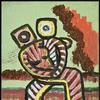Two Museums Plan Major Monet Retrospective of All the Artist's Favorite Places
- POTSDAM, Germany
- /
- February 05, 2019

The Museum Barberini and the Denver Art Museum are currently collaborating on a large-scale Monet retrospective, exploring the role of the places that inspired the artist as well as his approach to rendering their specific topography, atmosphere, and light.
The exhibition premieres October 21, 2019 to February 2, 2020 at the Denver Art Museum. Denver's presentation of Claude Monet: The Truth of Nature will uncover Claude Monet's (1840– 1926) continuous dialogue with nature and its places through a thematic and chronological arrangement, from the first examples of artworks still indebted to the landscape tradition to the revolutionary compositions and series of his late years.
From February 29 to June 1, 2020, the Museum Barberini in Potsdam, Germany, will present the co-organized exhibition with the title Monet: Places.
Featuring key loans, the exhibition, at Denver and Potsdam, explores Monet's approach towards the depiction of sites and topographies that influenced his stylistic development, including Paris and London, the Seine villages of Argenteuil, Vétheuil and Giverny, the coasts of Normandy and Brittany as well as Southern travel destinations such as Bordighera, Venice and Antibes. Amongst the show’s many highlights are numerous depictions of Monet’s garden and pond in Giverny, including several variations of his world-famous waterlilies.
[Also on view this year, The Fine Arts Museums of San Francisco (opening Feb. 16) and the Kimbell Art Museum in Fort Worth will show Monet: The Late Years, the first exhibition in more than 20 years dedicated to the final phase of Monet’s career.]

In the second half of the nineteenth century, the rise of Impressionism dramatically changed the evolution of European landscape painting. One of the movement’s most influential practitioners was Claude Monet, whose exceptionally prolific career spanned more than six decades. Although he was a highly versatile artist, Monet’s key interest lay on depictions of the natural world, characterized by a relentlessly experimental exploration of color, movement, and light. Inspired by the artistic exchange with his colleagues Eugène Boudin and Johan Barthold Jongkind, Monet’s early Impressionist compositions radicalized the practice of plein-air painting, as he largely rejected the studio in favor of working in open nature and directly in front of the motif.
More than any of his fellow Impressionists, he was deeply attracted to exploring the character of specific sites and locations in situ, from the sundrenched Riviera or the wind-swept, rugged coastline of the Belle-Île in Brittany to the picturesque banks of the river Seine. At the very heart of Monet’s artistic practice lay a keen interest in capturing the impression of a fleeting moment, as he tried to translate the most evanescent effects of the atmosphere into the material structure of paint. “For me, a landscape does not exist in its own right, since its appearance changes at every moment”, Monet explained in 1891. “But its surroundings bring it to life – the air and light, which vary continually (…). For me, it is only the surrounding atmosphere which gives objects their real value.”
From his very first documented composition through to the late depictions of his farmhouse and water-garden in Giverny, the show Monet: Places offers a rich overview of his entire career, demonstrating his unique place within the French avantgarde of his time. The show engages with some of the major questions that were already touched upon by the museum’s opening exhibition Impressionism: The Art of Landscape, which attracted over 320,000 visitors in its three-month run in 2017.

Daniel Zamani, curator at the Museum Barberini, explains: “Monet’s career has been the subject of intense scholarly scrutiny, but our focus on the places that inspired him offers new insights into his artistic interests and methods. Our aim is to demonstrate just how significant specific topographies were at key junctures in Monet’s career and to look more deeply into how and why these places influenced his development as a painter.”
Catalog:
The exhibition will be accompanied by a lavishly illustrated 280-page catalog, including contributions by some of the leading scholars on Impressionist painting, amongst them Marianne Mathieu, James Rubin, George T. M. Shackelford, Richard Thomson, and Paul Tucker. All of the catalog essays have been prepared through an international Monet conference that took place at the Museum Barberini in January 2019.















